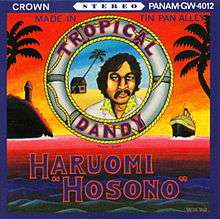Tropical Dandy
Tropical Dandy is Haruomi Hosono's second solo album. This album continues the tropical style of Hosono House (which would continue later on with Bon Voyage co. and Paraiso) and also features performances from "Caramel Mama" (who had, by this point, changed their name to "Tin Pan Alley"). This album was re-issued as part of a box set with bonus tracks taken from Tin Pan Alley albums by Crown decades later.[1][2][3]
| Review scores | |
|---|---|
| Source | Rating |
| The Wire | favorable[4] |
| Tropical Dandy | ||||
|---|---|---|---|---|
 | ||||
| Studio album by | ||||
| Released | June 25, 1975 | |||
| Recorded | Crown Studio Akasaka, Minato, Tokyo | |||
| Genre | Jazz fusion, exotica | |||
| Length | 34:22 | |||
| Label | PANAM, CROWN | |||
| Producer | Haruomi Hosono | |||
| Haruomi Hosono chronology | ||||
| ||||
| Singles from Tropical Dandy | ||||
| ||||
Track listing
All tracks are written by Haruomi Hosono, except "Chattanooga Choo Choo", with music by Harry Warren, lyrics by Mack Gordon and lyrics translated by Hosono; "Hyōryūki", "Sanji no Komori Uta" & "“Yoimachigusa”'s Theme", written by Hosono with horns & strings arranged by Makoto Yano; "Choo Choo Gatagoto'75", written by Hosono, arranged by Tin Pan Alley with chorus arranged by Tatsuro Yamashita and "Yellow Magic Carnival", written by Hosono, arranged by Tin Pan Alley with strings arranged by Masataka Matsutoya.
| No. | Title | Length |
|---|---|---|
| 1. | "Chattanooga Choo Choo" | 2:49 |
| 2. | "Hurricane Dorothy" | 5:46 |
| 3. | "Silk Road" (絹街道 Kinukaidō) | 3:32 |
| 4. | "Tropical Night" (熱帯夜 Nettaiya) | 4:55 |
| 5. | "Peking Duck" (北京DUCK Pekin Duck) | 2:36 |
| 6. | "Drifting Chronicle" (漂流記 Hyōryūki) | 3:08 |
| 7. | "Honey Moon" | 2:37 |
| 8. | "Three o'Clock Lullaby" (三時の子守唄 Sanji no Komori Uta) | 2:31 |
| 9. | "Three o'Clock Lullaby" (三時の子守唄 Sanji no Komori Uta) (instrumental) | 2:26 |
| 10. | "Drifting Chronicle" (漂流記 Hyōryūki) (instrumental) | 4:02 |
| No. | Title | Originally from | Length |
|---|---|---|---|
| 11. | "Choo Choo Gatagoto'75" (CHOO CHOO ガタゴト'75) | Caramel Mama, 1975 | 3:17 |
| 12. | "Yellow Magic Carnival" | Caramel Mama, 1975 | 3:34 |
| 13. | "Rose and Beast" (薔薇と野獣 Bara to Yajū) | Tin Pan Alley 2, 1977 | 4:13 |
| 14. | "Ballad of Aya" (アヤのバラード Aya no Barādo) | Caramel Mama, 1975 | 1:37 |
| 15. | "Theme of “Evening Primrose” Part 1〜Drifting Chronicle" (“宵待草”のテーマ Part 1〜漂流記 “Yoimachigusa” no Tēma Part 1〜Hyōryūki) | Yoimachigusa (soundtrack), 1975 | 4:09 |
| 16. | "Theme of “Evening Primrose” Part 2〜Drifting Chronicle" (“宵待草”のテーマ Part 2〜漂流記 “Yoimachigusa” no Tēma Part 2〜Hyōryūki) | Yoimachigusa (soundtrack), 1975 | 1:36 |
Album cover
The album's cover is a parody of the sailor-themed packaging of Player's Navy Cut cigarettes, similar to the 1969 Procol Harum album, A Salty Dog. The quotation marks around Hosono's surname is in reference to the "medium" version of the cigarette. The cover also portrays a ship resembling the RMS Titanic, which Hosono's grandfather Masabumi infamously escaped the sinking of on her maiden voyage.
Personnel
- Haruomi Hosono - Bass, Vocals, Mellotron, Marimba, Guitar (Acoustic & Electric), Clavinet, Cowbell, Whistle, Backing Vocals/Choir, Production, Liner notes
- Masataka Matsutoya - Piano, Hammond organ, String Arrangements
- Shigeru Suzuki - Electric Guitar, Backing Vocals/Choir
- Tatsuo Hayashi - Drums, Percussion
- Hiroki Komazawa - Pedal steel guitar
- Hiroshi Satō - Piano, Clavinet
- Ginji Itō - Electric Guitar
- Motoya Hamaguchi - Percussion
- Makoto Yano - Strings, Horn (Wind and Brass) & String Arrangements
- Minako Yoshida - Duet Vocals, Backing Vocals/Choir
- Makoto Kubota - Backing Vocals/Choir, Scat Vocals
- Teruyuki Fukushima - Trumpet
- Masayuki Kuniyoshi - Flute
- Yōji Yamashita - Ukulele
- Clare Francis - Voice
- Kayo Ito, Taeko Ōnuki & Kōsetsu Minami - Backing Vocals/Choir
- Kazuhiro Ichihashi - Backing Vocals/Choir, Assistant Engineering
- Shincihi Furuzaki - Re-mixing
- Yasuo Yagi - Cover and Back Tropical Artwork, Concept Art
- Michiko Oshima - Liner Artwork
- Takumi Uchida - Photography
References
- Powell, Mike (1 January 2008). "Found Sound 2007". Pitchfork. Retrieved 10 March 2014.
Hosono deserves distinction for prefiguring stuff like Pizzicato Five and Momus and Stereo Total
- Bell, Clive (August 1997). "Sayonara Cruel World". The Wire (subscription required). pp. 33–34. Retrieved 10 March 2014.
It combines Martin Denny's already outdated 'Exotica' and fake orientalism with Dr John-style New Orleans piano.
- Hosokawa, Shuhei (1999). "Haruomi Hosono and Japanese Self-Orientalism". In Philip Hayward (ed.). Widening the Horizon: Exoticism in Post-war Popular Music. Indiana University Press. p. 124. ISBN 9781864620474. Retrieved 11 March 2014.
reminiscence of a childhood both overwhelmed and enlivened by Americanism
- Baxter, Ed (September 1995). "Haruomi Hosono: Tropical Dandy". The Wire (subscription required). pp. 53–54. Retrieved 10 March 2014.
Infectious, veering towards kitsch, it mixes louche cabaret music, rock and traditional instruments with (for its time) state of the art synths, judiciously employed choruses and string sections, and ersatz environmental sound...